Salford Corporation Tramways
History
Salford Corporation became the owner of an operational horse-drawn tramway on the 17th May 1877, when the newly built, standard-gauge line between Pendleton and Higher Broughton (Kersal Bar) — via Albert Bridge and Deansgate, in Manchester — was opened. The tramway was branded as 'Manchester and Salford Tramways' with each corporation owning the tracks in their respective municipalities. Operation of the line was leased to Messrs Busby and Turton, two well-known figures in the tramway world who, without the knowledge of the corporations, transferred the lease to the Manchester Carriage Company. The corporations took an extremely dim view of this, so much so that they refused to formally recognise the MCCo as the lessee, even though it ran all the services! Messrs Busby and Turton had never had any intention of operating the tramway themselves, and this move essentially set the tone for future relations, particularly with Salford Corporation, as all their planned lines, unlike those of Manchester Corporation, had also been included in the original lease. The dispute over the lease even continued after the 2nd August 1880, when the MCCo was merged with the Manchester Suburban Tramways Company (this was a vehicle used by Busby, Turton and the MCCo to secure tramway powers) to form the Manchester Carriage and Tramways Company. The dispute was eventually resolved on the 25th June 1890, a staggering 13 years after matters first came to a head.
At its maximum, Salford's horse-drawn tramway system totalled 13.32 route miles, comprising: a line northwestwards from the Manchester boundary along Bury New Road to Higher Broughton; a line northwestwards from the Manchester boundary at Blackfriars Bridge along Lower Broughton Road to Laurel Grove (with a loop off it along Clowes Street and Camp Street); a line westwards from the junction of Blackfriars Street and Chapel Street to Pendleton; a line southwestwards from Pendleton to the boundary with Barton and Eccles Local Board at Gildabrook, where it met that authority's line to Peel Green; a line northwestwards from Pendleton to the borough boundary at Irlam O'Th'Heights, where it met the MC&TCo's tracks to Swinton and Pendlebury; and a line westwards from the Manchester boundary at Regents Bridge, through Weaste, to meet Barton and Eccles Local Board tracks at Ladywell.
By 1896, both Salford and Manchester had decided to convert their respective tracks to electric traction, and with this in mind, Salford extended its MC&TCo leases such that they all expired on the same day as Manchester's, the 27th April 1901. Unlike Manchester, which arranged for the MC&TCo to continue working its lines whilst they were converted, Salford chose to do this itself, only taking over on the 2nd May due to an eleventh-hour disagreement over the purchase price.
Construction of new lines had begun in April 1900, with the first overhead electric service commencing on the 4th October 1901 and the last horse tram probably running on the 24th March 1903. The electric tramway system was largely complete by the mid-Edwardian era, and was well run and well patronised; it delivered a strong performance right through to 1926.
Like many systems, it was placed under immense strain during the Great War, emerging from it with a significant backlog of maintenance and renewals. Despite greatly increased post-war costs, and the growing threat of independent bus competition, the corporation continued to invest heavily in its tramways. The corporation did, however, anticipate developments, introducing its first bus service on the 20th July 1920, and steadily expanding them as the decade wore on. The largely unregulated bus competition inevitably led to a sharp drop in tramway revenue, with the enterprise making a loss for the first time in 1926; matters were though gradually turned around through service cut-backs, municipal cooperation and greatly increased revenue from the department's own buses.
The first tramway closure came on the 19th July 1931 when the Trafford Park-Stretford line was closed to allow Trafford Park Swing Bridge to be rebuilt, following which buses were substituted. Closures took place throughout the 1930s as track renewals and leases became due, though these were to come to a temporary halt during the Second World War, after which the closures resumed. The name of the undertaking was changed to Salford Corporation Transport sometime in the mid-1930s, and again — in 1946 — to Salford City Transport, to reflect the bus-dominated services. The last Salford tram service ran on the 31st March 1947.
At its height, Salford Corporation operated 38.8 route miles of tramway, 19.31 miles owned by the corporation, 5.12 miles by Eccles Corporation, 3.65 miles by Swinton and Pendlebury UDC, 3.88 miles by Prestwich UDC, 2.15 miles by Whitefield UDC; 0.65 miles by the South Lancashire Tramways Company; 2.5 miles by the Trafford Park Estates Company; and 4.04 miles of Manchester Corporation-owned track.
The system comprised lines: northwards to Whitefield via Bury New Road and Bury Old Road (with a loop along Great Clowes Street to The Cliff); northeastwards to Rhodes (later extended to Middleton); southwards to Stretford; westwards to Eccles, Peel Green, Winton and Worsley; and northwestwards to Swinton, Pendlebury and Clifton. Salford tracks met those of the South Lancashire Tramways Company (at Winton, Swinton and Clifton), Bury Corporation Tramways (at Whitefield); the Middleton Electric Traction Company (at Rhodes); and Manchester Corporation Tramways at several points. At various times, through-running agreements were put in place which saw SCT cars reach Walkden, Farnworth, Worsley, Bury, Middleton (Mills Hill), Manchester, Levenshulme and Reddish, whilst those of the MCT, SLTCo and BCT all ran through to Salford.
Uniforms
Salford Corporation took over operation of the horse-drawn lines it had previously leased to the Manchester Carriage and Tramways Company Limited in 1901, and photos taken in this period clearly show drivers and conductors wearing informal attire such as heavy jackets, flat caps and bowler hats, effectively continuing the policy of their former employers.
Following electrification, tramcar crews were issued with single-breasted jackets with five buttons (these were brass and carried the full system title and corporation coat of arms — see link) and stand-up collars; the bearer's left-hand collar carried an employee number (in individual brass numerals), whilst the right-hand collar bore ’S C T’ system initials (in individual brass letters). Until 1915, motormen were allocated odd numbers, and conductors even numbers (my thanks to the late Ted Gray for this information). The collars were embellished with material of a lighter colour than the main body of the jacket — no doubt intended to give a smarter appearance — and this was almost certainly used on the sleeves and trousers, the former having chevrons around the cuffs and the latter being piped.
Caps were originally of the drooping-peak type, but these were quickly replaced by soft-topped peaked caps, which themselves seem to have been fairly quickly superseded by tensioned-crown, peaked caps, the latter having a woven straw upper. The caps bore script-lettering grade badges — either 'Motorman' or 'Conductor' — along with a small municipal device badge; the grade badges appear to have been dispensed with around 1905, after which the caps simply bore the municipal-device badge.
From the late-Edwardian era onwards, motormen increasingly wore double-breasted, lancer-style tunics with five pairs of buttons (narrowing from top to bottom) and with stand-up collars; the latter carried the same insignia as the earlier jackets. The style of the uniforms was subtly altered around 1916 by the addition of epaulettes; these had a button fastening at the neck end and bore a prominent oval brass badge with 'SALFORD CITY TRAMWAYS' around the circumference, and an employee number in the centre, the latter in nickel numerals. This badge effectively replaced the collar insignia, which were therefore dispensed with. Around the same time, the small municipal-device badge was superseded by a larger more elaborate pattern of municipal cap badge incorporating the full arms within a laurel wreath. The latter badges were issued in brass initially, though a switch was possibly made to nickel and/or chrome in later years. As the name of the undertaking was changed sometime in the mid-1930s — to Salford Corporation Transport — it is likely that tramcar staff would have worn uniforms bearing Salford Corporation Transport insignia in the last decade or so of the tramway's existence. With the exception of the epaulette badges, which remained brass, these insignia would probably have have been nickel, though they were eventually switched to chrome. In later years, the epaulette badges were used exclusively on senior staff uniforms, though this was possibly only well after the demise of the trams.
In the interwar years, various changes were made to the style of the jackets in-line with the prevailing fashions, firstly by the addition of breast pockets, and finally to a more modern cut with lapels and epaulettes.
Another change in the name of the department took place in 1946, to Salford City Transport. This was right at the end of tramway operation (31st March 1947), so there is a possiblility that some tramwaymen may have been issued with new uniforms bearing buttons and badges with the new name.
Tramcar staff were also issued with long, double-breasted greatcoats with five pairs of buttons and high, fold-over collars; like the tunics worn underneath, the collars bore system initials and an employee number. When the uniform jackets were supplemented by epaulettes during the Great War, it seems that the greatcoats were treated likewise, with the collars no longer carrying employee numbers, these being replaced by the oval Employee Number badge on the epaulettes.
Salford, along with Manchester, was a great employer of trolley boys, young lads who assisted the conductor, for example, by directing passengers and, as the name implies, moving the trolley boom. The uniforms appear to have been identical to those worn by conductors and motormen, but without the oval employee number badge, simple numerals being worn instead. The position was dispensed with in 1930.
In the early years of the system, inspectors appear to have worn a very similar uniform to conductors and motormen, deviating only in the use of 'Inspector' script-lettering badges on both the collars and the caps, the former embroidered and the latter metal. It is unclear what jackets were worn by inspectors in later years, as surviving photographs only show them in long gabardine overcoats. Chief inspectors wore elaborate single-breasted jackets with hidden buttons (or more likely an hook and eye affair), heavily embellished with bandmaster-style frogs and braiding. By the time of the Great War, the caps of the tensioned-crown, peaked type; they bore a hat band, which carried an elaborate cap badge, the precise details of which are currently unknown.
In common with many UK tramway systems, Salford employed the services of female staff during the Great War — as conductresses — to replace men lost to the armed services; these ladies were issued with long, single-breasted tunics with five buttons, an integral belt with button fastening, two hip-level pockets, epaulettes, and a long matching skirt. In early-to-mid 1916, the jackets were altered to a somewhat smarter design, which although similar, now had two breast pockets (with button closures), but with the collars and epaulettes edged in a finer and different coloured material than the main body of the jacket; the sleeves of these jackets were also embellished with chevrons (again of a lighter colour than the main body). The first hats were woven-straw bonnets, light in colour, with the standard small pattern municipal-device badge mounted on a half rosette in the centre. In 1916, the bonnets appear to have been changed to a darker coloured, water-resistant type, still straw, but now bearing a hat band with the new, more elaborate municipal cap badge. Various other types of headwear appear in the photographic record, though which was corporation-issued and which merely informal attire, is difficult to say.
The SCT also used trolley girls during the Great War; they were issued with a simpler style of uniform than the conductresses, comprising a single-breasted jacket devoid of pockets, identical to those worn at the time by trolley boys. They were provided with thick (probably serge) brimless bonnets which bore the standard municipal cap badge.
Conductresses were also issued with long, single-breasted top coats with a waist belt, epaulettes and high fold-over collars, all of which were edged in a finer material than the main body of the jacket. The buttons were offset to one side of the garment. There appear to have been two varieties, one of heavier weight, and one of a lighter weight, presumably for winter and summer wear, respectively.
The SCT also employed the services of female inspectors. These ladies wore a very similar uniform to their conducting counterparts, but with the addition of a much broader-brimmed straw bonnet; this carried a hat band, upon which a large cap badge was mounted, almost certainly the same pattern as those worn by male inspectors. A concession was also made for the hotter months of the year, in the form of a summer uniform; the main difference being the jacket, which was double-breasted with lapels rather than high fold-over collars; it was probably cut somewhat shorter as well.
Further reading
For a detailed history of the system, see: 'Salford's Tramways, Parts 1 and 2' by Edward Gray; Foxline Publishing (1997 and 1999).
Images
Horse tram drivers and conductors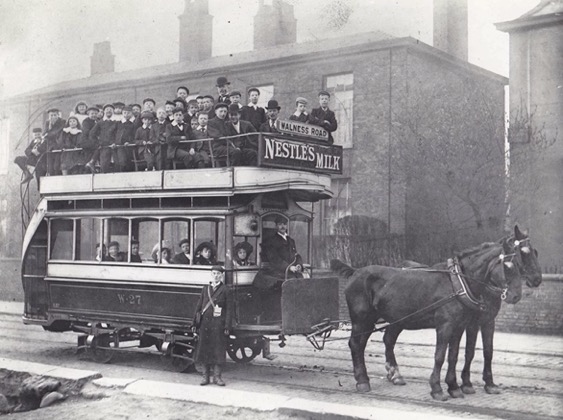
Conductor J E Thompson and his driver pose with Horsecar W27 of the former Manchester Carriage and Tramway Company in Lower Broughton Road; although the photograph is undated, it certainly post-dates the takeover by Salford Corporation (28th April 1901). With thanks to the late Ted Gray. 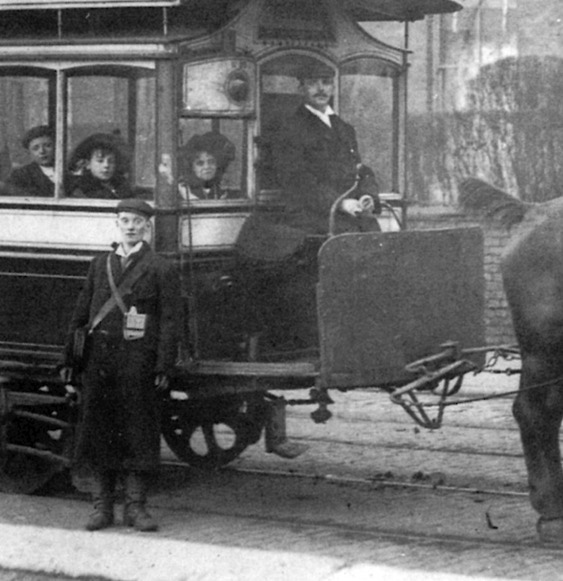
An enlargement of the above photograph showing Conductor Thompson and his driver. Neither man is wearing a licence badge, and the appearance of the staff is generally somewhat less smart than in the heyday of the MC&TCo.
Motormen and conductors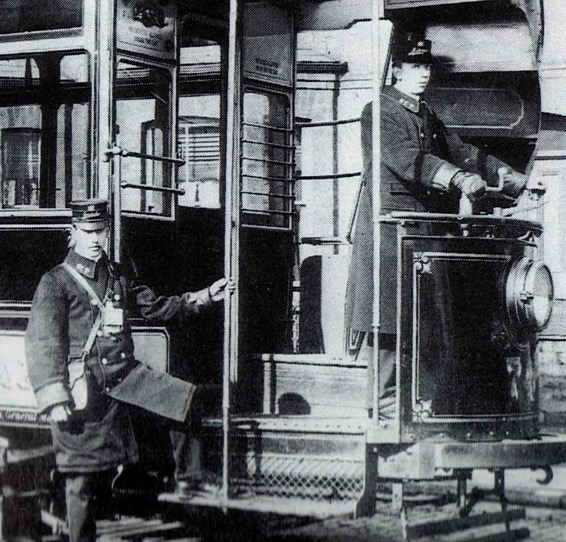
A conductor and a motorman aboard Tramcar No 74 at the Peel Green terminus in October 1902. Both men are wearing piped, drooping-peak caps adorned with script-lettering grade badges — 'Motorman' or 'Conductor' — along with a small municipal-device badge. The right-hand collars of their greatcoats bear individual 'S C T' initials. With thanks to Salford Local History Library and Ted Gray.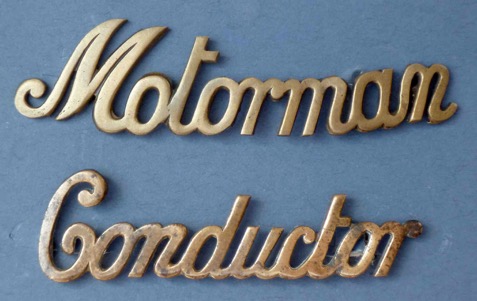
General pattern script-lettering cap badges — 'Motorman' and 'Conductor' brass, of the type used by the SCT from 1901 to around 1905. Author's Collection.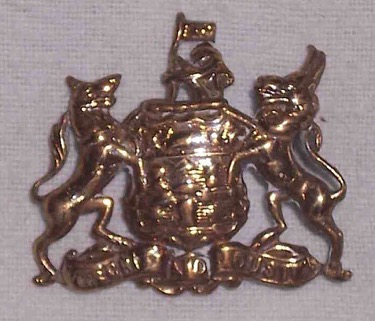
Salford Corporation Tramways municipal-device cap badge — brass. These badges were worn between 1901 and around 1916, at which time they were replaced by a larger, more elaborate badge (see below). Author's Collection.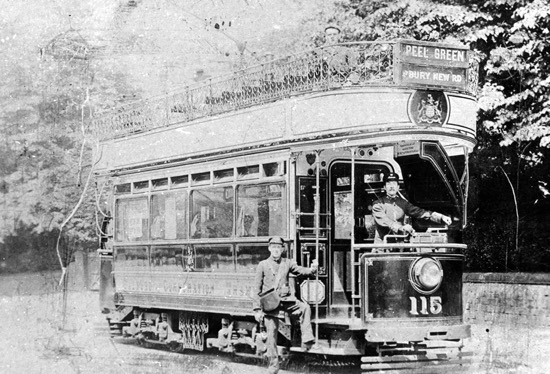
A conductor and a motorman pose for the cameraman with what looks to be a fairly new Tramcar No 115 on a Peel Green service, which would date the image to 1903 or 1904. With thanks to Bury Image Bank (see link); Image b03568 — copyright Bury Archive Services.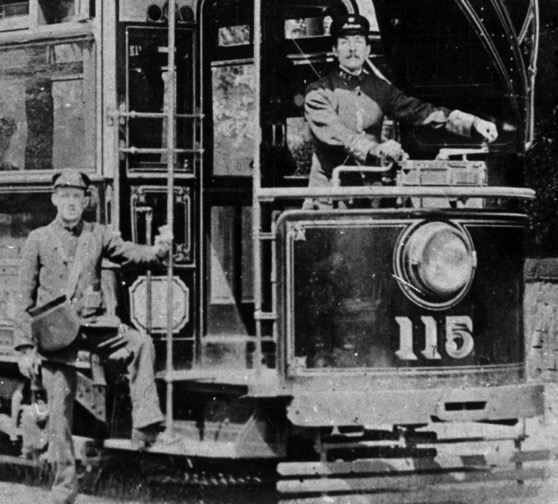
An enlargement of the above photograph showing the crew. By this time the drooping-peak caps had clearly been superseded by soft-topped peaked caps, though they continued to carry the same badges as previously.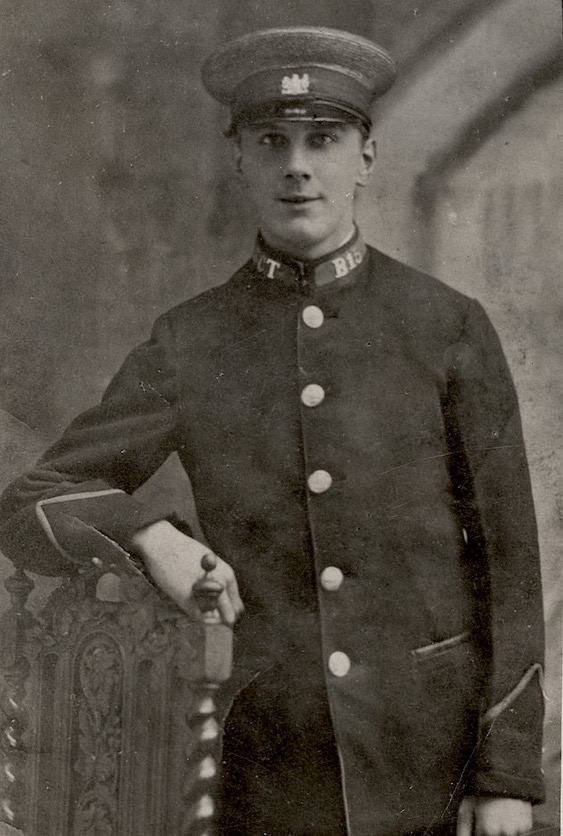
A studio portrait of an SCT tramwayman, Employee B15 — photo undated, but probably late Edwardian. It is unclear what the 'B' prefix denoted, though he may possibly have been a trolley boy. Author's Collection.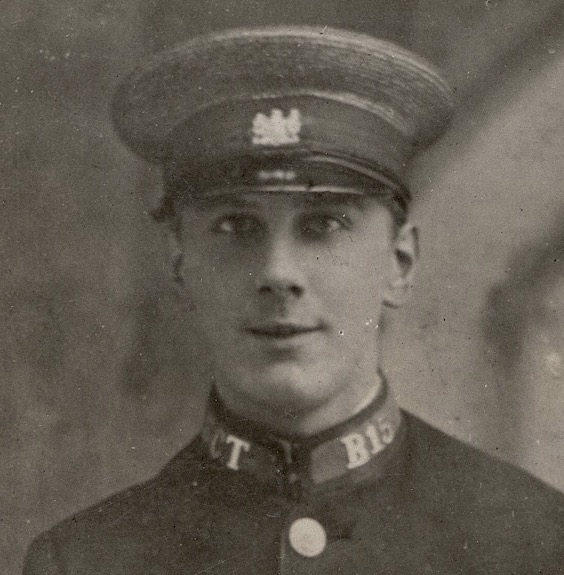
An enlargement of the above photograph showing details of the collar insignia and the tensioned-crown peaked cap, by this time without a grade badge. The crown is of woven straw, a type favoured by several tramway companies.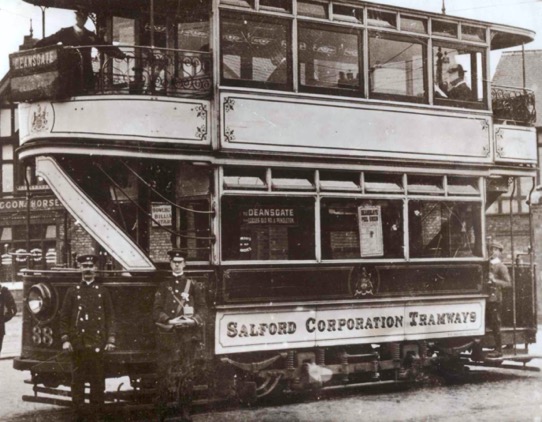
Tramcar No 88 and crew stand outside the Waggon and Horses public house at the Peel Green terminus — circa 1914. With thanks to Roy Pinches.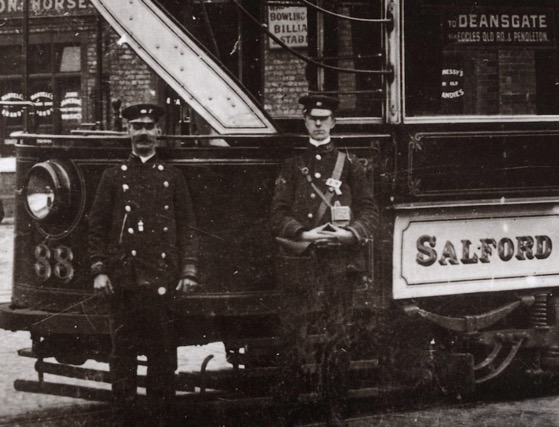
An enlargement of the above photograph showing the motorman and the conductor. Whilst the conductor still has the same style of single-breasted jacket worn since the inception of electric services, the motorman is wearing a double-breasted lancer-style tunic.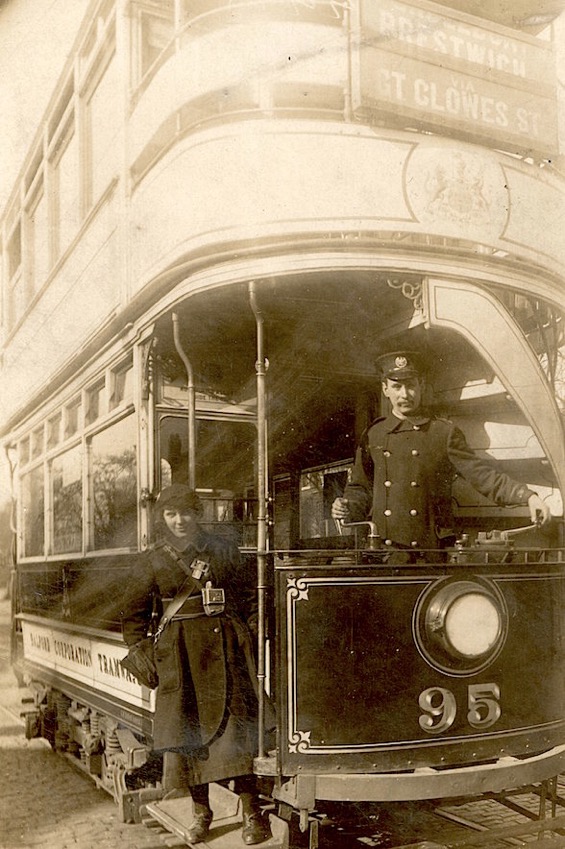
A Great War conductress and a motorman with Tramcar No 95 on a service to Prestwich via Great Clowes Street. Author's Collection.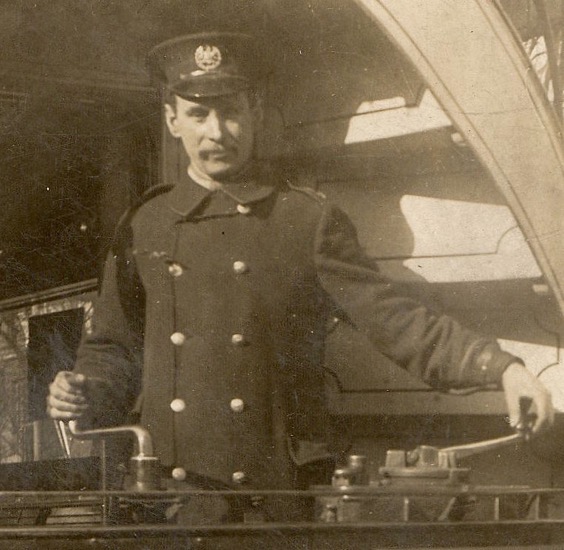
An enlargement of the above photograph showing the motorman, in double-breasted greatcoat, which save for the epaulettes, appears to be devoid of insignia. His cap on the other hand bears the elaborate cap badge introduced circa 1916.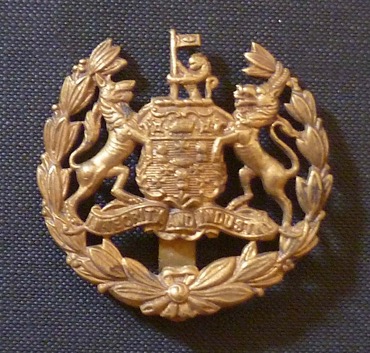
Salford Corporation Tramways cap badge — brass. This pattern of cap badge was worn from around 1916 right through to the ultimate demise of the system in 1947, though whether brass or nickel was used is currently unclear. The badge is affixed by a slider rather than lugs, a style of fixing used extensively on military cap badges, but to the best of my knowledge, uniquely so by Salford (amongst tramway concerns). This pattern of badge was apparently used widely by the corporation's various departments, so was not confined to tramwaymen. Author's Collection.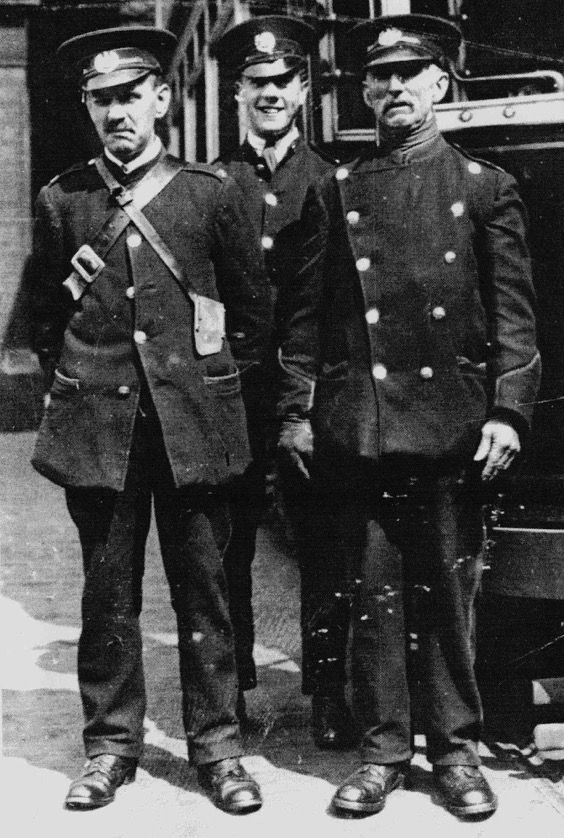
Two conductors and a motorman, captured for posterity in 1923. By this time, the jacket collars were plain, with the employee numbers being borne on the epaulettes within an oval badge. With thanks to Salford Local History Library and Ted Gray.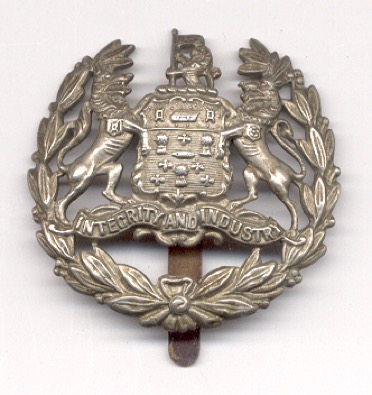
Salford Corporation cap badge— nickel. It is currently unclear whether the tramway department used only brass or whether a transition was made to nickel. With thanks to John Johnston.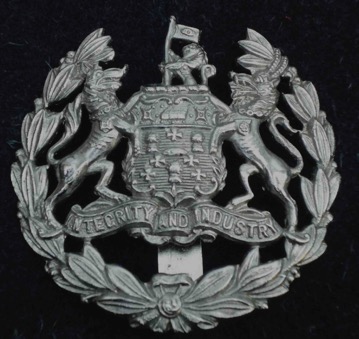
Salford Corporation cap badge — chrome. New badges were possibly issued in this material from the late 1930s or early 1940s onwards. Author's Collection.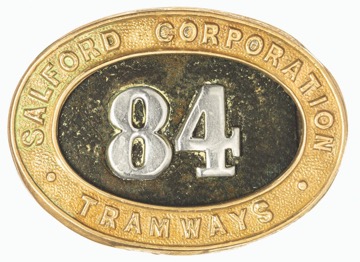
Salford Corporation Tramways epaulette badge — brass with nickel numbers. These badges were introduced around 1916, and were possibly replaced by the 'SALFORD CORPORATION TRANSPORT' equivalent in the 1930s. Author's Collection.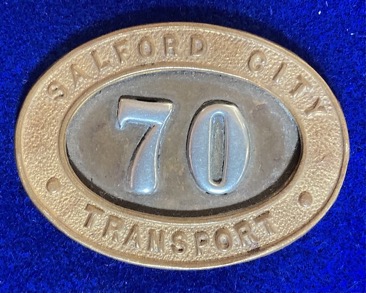
Salford City Transport epaulette badge — brass with nickel numbers. These badges were probably introduced around the time the tramway closed, so it is unclear whether tramwayman would ever have worn them. Author's Collection.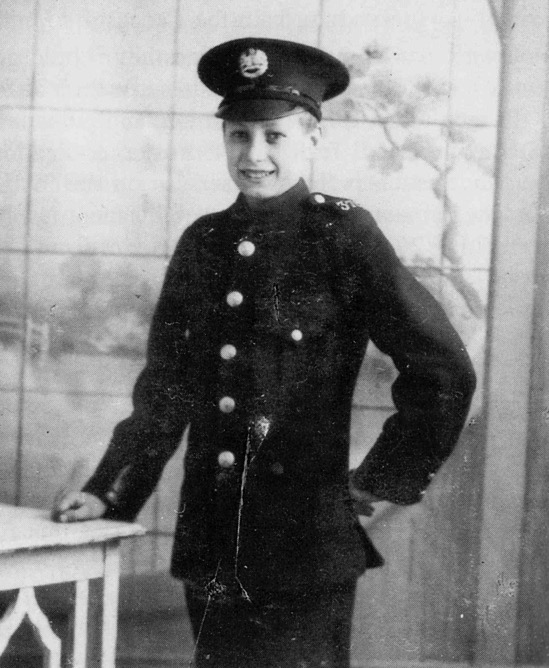
William Whittingham’— an SCT trolley boy — taken in 1930, the year the position was dispensed with. The noticeable lustre of the cap badge suggests that it may have been chrome, though this would have been very early for this material (see link). With thanks to Salford Local History Library and Ted Gray.
Senior staff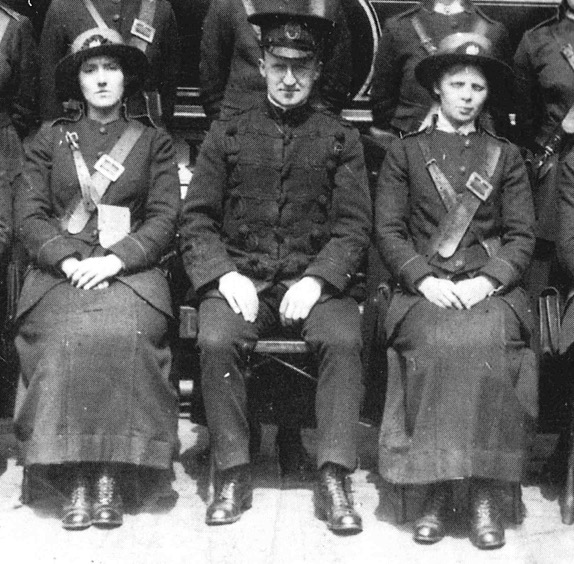
Chief Inspector Dunn poses for the cameraman with a group of conductresses in 1915. The elaborately braided tunic is typical of this grade on the larger tramway systems. With thanks to Salford Local History Library and Ted Gray.
Female staff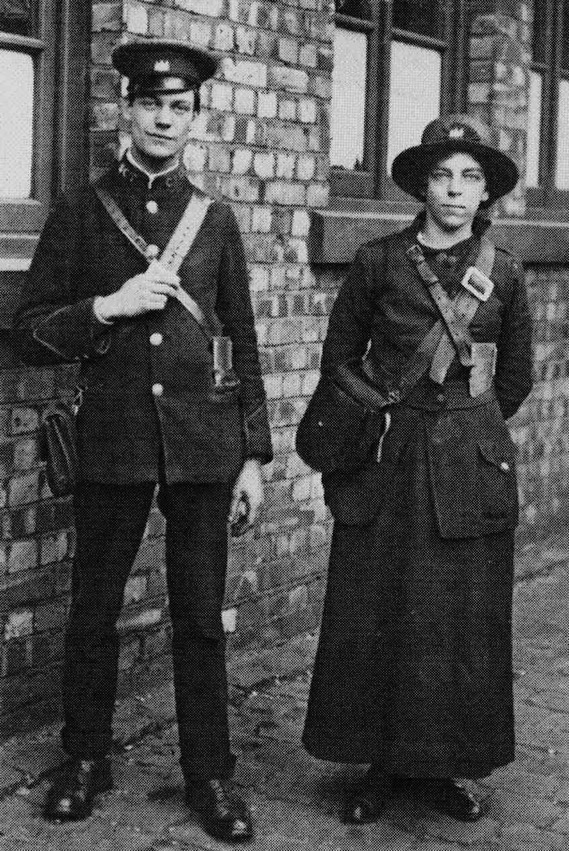
An early photograph of an SCT Great War conductress, taken in 1915. Her bonnet bears the standard municipal-device cap badge on a half rosette. With thanks to Salford Local History Library and Ted Gray.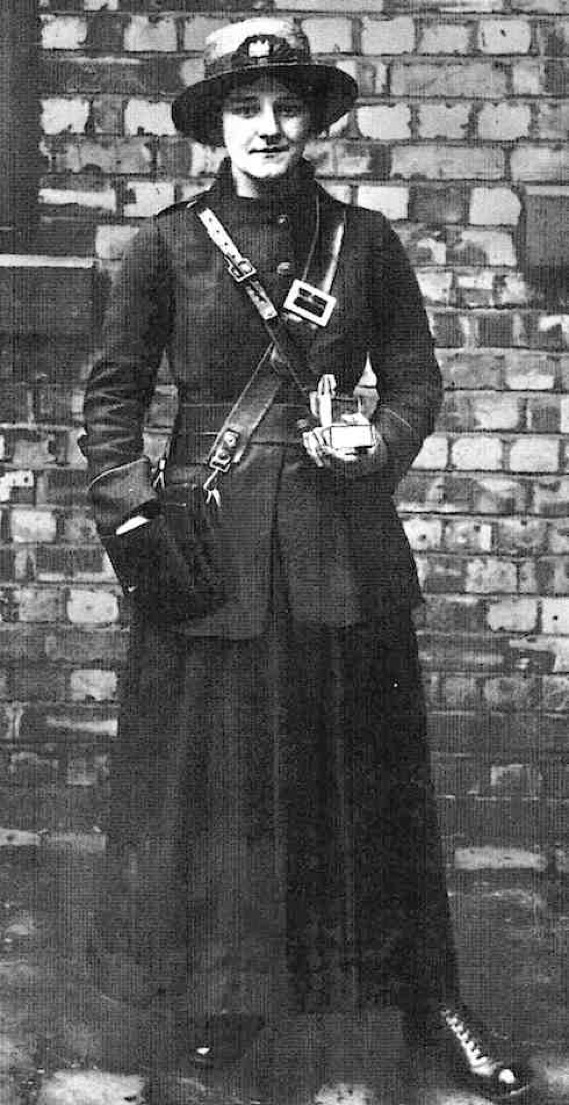
An SCT Great War conductress — dated 1915. With thanks to Salford Local History Library and Ted Gray.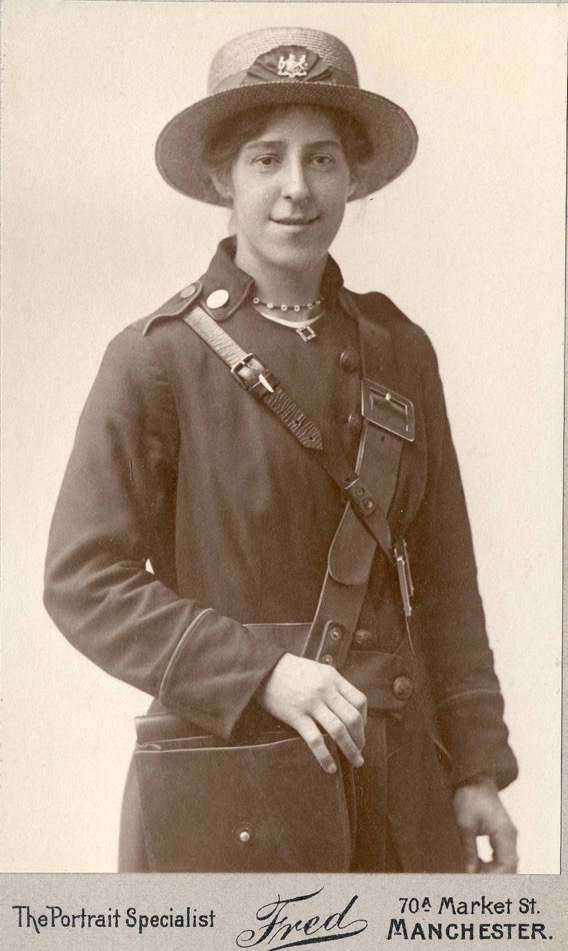
A studio portrait of an SCT Great War conductress — photo undated, but given that she is wearing the small municipal-device badge, probably taken in 1915 or early 1916. Her topcoat appears to be of a lighter weight than those seen in some other photos, and her hat is a light-coloured straw bonnet, so in all probability, the photo was taken in summer. Author's Collection.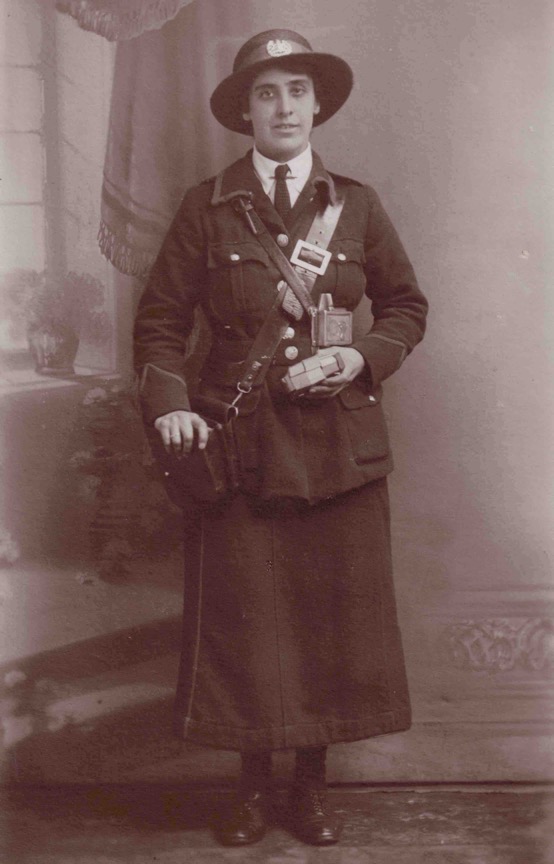
A photograph of a Great War SCT conductress taken in the studios of Stanley & Co, Bread Street, Pendleton, Manchester. The subject is wearing the new style of uniform with two breast pockets, which if the date on the rear of the photograph is to be believed (July 1916), suggests that the uniform change was made shortly before the summer of 1916. Author's Collection.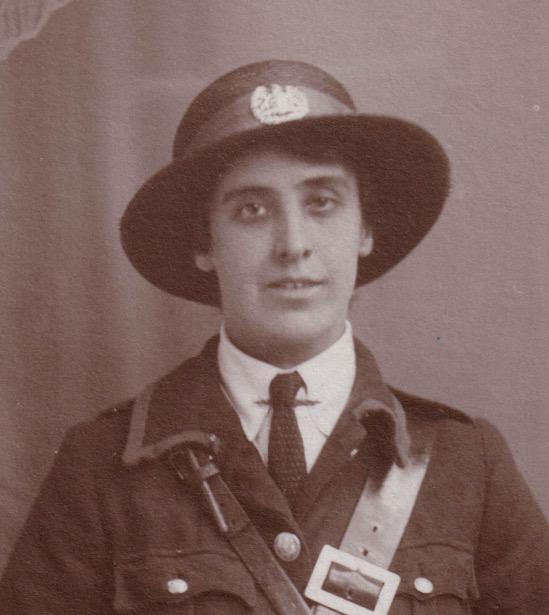
An enlargement of the above photograph showing details of the jacket collars and the recently introduced more elaborate cap badge.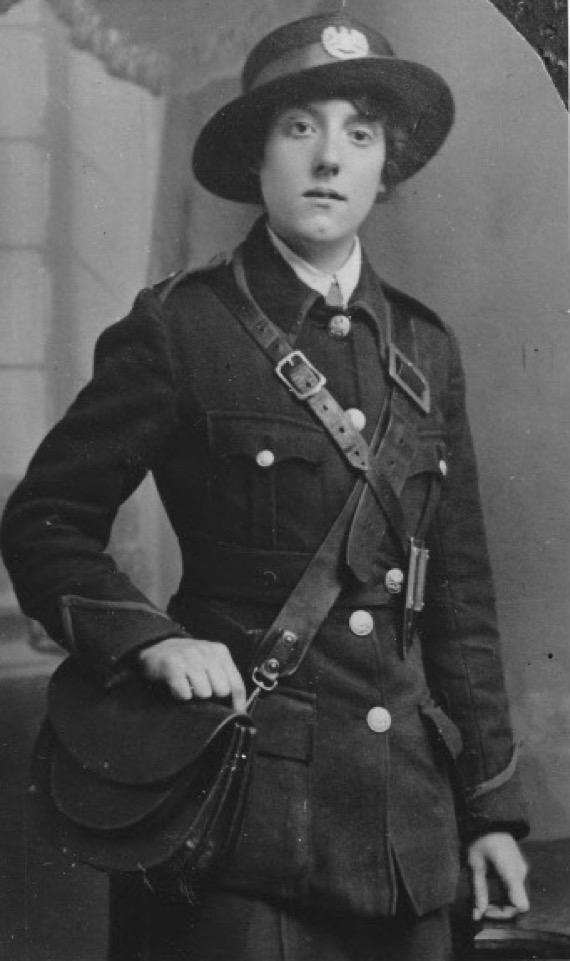
SCT Conductress Williams — photo undated, but given that she is wearing the new pattern of cap badge and a new style of jacket with breast pockets, certainly taken no earlier than summer 1916. The oval employee number badge, which was probably introduced in early 1916, can just be glimpsed on her right epaulette. With thanks to Ted Gray.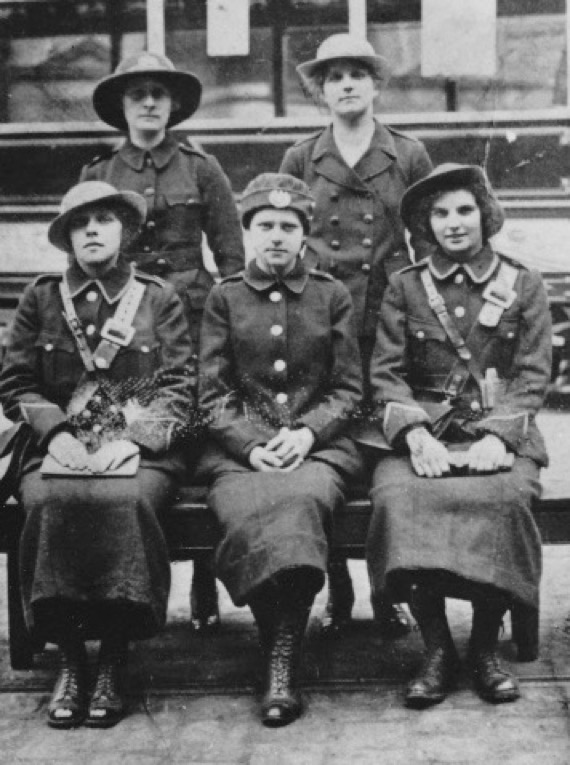
A group of conductresses (seated left and right), two lady inspectors (standing) and a trolley girl, probably (seated centre) — photo undated, but certainly taken during the Great war. The lnspectress on the left is wearing a winter uniform, whilst the lady on the right wears the summer version. The trolley girl is wearing a brimless bonnet, a type of hat also used by Manchester Corporation Tramways for trolley girls. The other headgear looks to be informal, suggesting that they had possibly run out of standard issue bonnets, perhaps unsurprising given that Salford ended up employing well over 300 conductresses. With thanks to Ted Gray.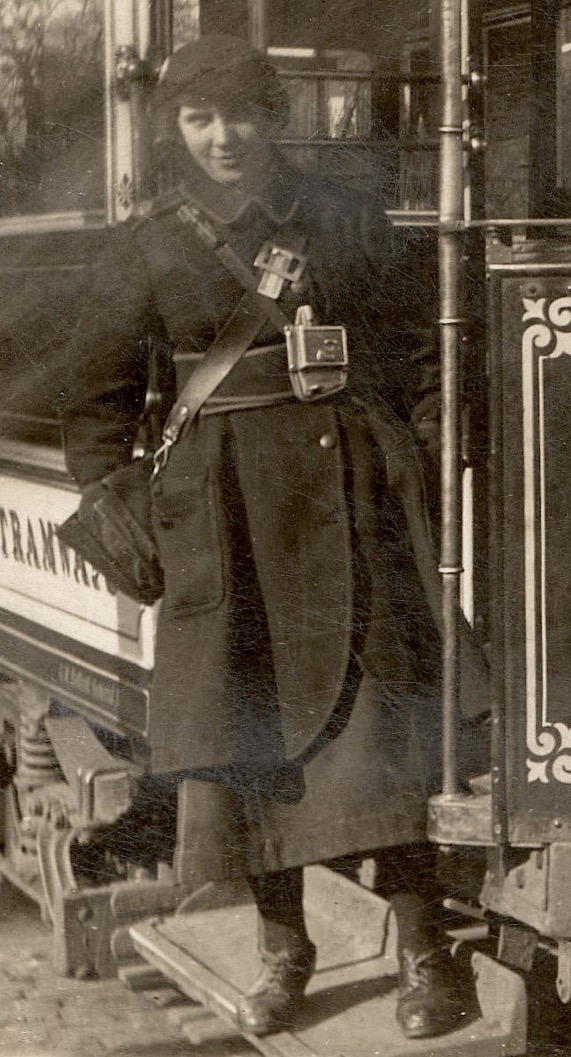
An enlargement of the shot of Tramcar No 95 above showing the conductress. She is wearing a long, single-breasted top coat with the buttons offset to one side rather than down the middle. This would appear to be a thicker garment than the one shown in the studio portrait above.